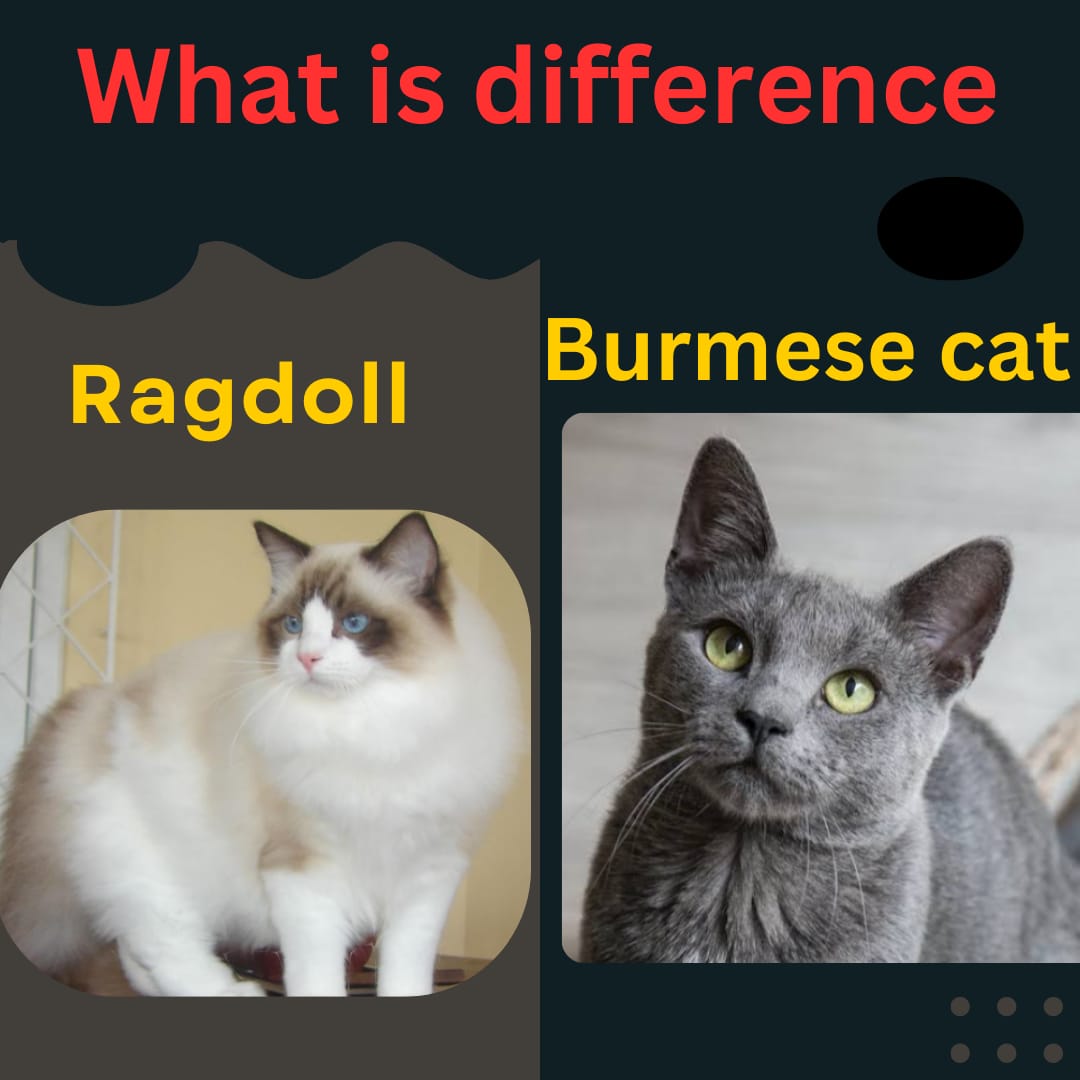If you are a cat lover looking for an affectionate and beautiful cat companion, you have a good chance of looking at the Burmese and the Ragdoll. Both breeds are famous for their loving nature and stunning personality, but they differ significantly in temperament, activity level, and grooming needs. Burmese cats are medium-sized, highly energetic, low-grooming, and social, thriving on constant interaction. Ragdolls are larger, more relaxed, moderate-grooming, and famous for their docile and easy-going temperament.
In this article, we will explore everything about Burmese and Ragdolls to help you decide which cat is ideal for your home and lifestyle.
Burmese vs Ragdoll Overview
| Traits | Burmese | Ragdoll |
|---|---|---|
| Height | 8-10 in | 9-11 in |
| Weight | 6-12 lb | 10-20 lb |
| Color | Solid: sable, champagne, blue, platinum | Pointed: seal, blue, chocolate, lilac, more |
| Personality | playful, Social | calm, laid-back |
| Lifespan | 10-15 yrs | 12-17 yrs |
| Grooming | Low | Moderate |
| Health | Some genetic issues | Generally healthy, some cardiac risk |
Origin and History
The Burmese cat originated in Burma (modern Myanmar), where it was naturally found and revered as a sacred companion. The modern Burmese breed was developed in the 1930s when Dr. Joseph Thompson brought a cat named Wong Mau from Burma to America.
The Wong Mau was discovered as a hybrid, possibly the result of a natural hybrid between a Siamese and a local Burmese cat. Dr. Thomson bred it from the Siamese, which contributed to the development of the modern Burmese breed, noted for its muscular structure and silky, shiny coat.
While the breed’s foundation lies in natural origins, its development into the Burmese we know today involved selective breeding. This breed was officially recognized by the International Cat Association (TICA) and the Cat Fanciers’ Association (CFA) in 1936.
Physical Appearance
Burmese cats are smaller than Ragdoll cats, with a sleek, muscular build. They typically weigh between 8 and 12 pounds and have a strong, athletic frame. Their short coat is silky and comes in solid colors such as sable, champagne, blue, and platinum.
These cats have short legs, striking gold or yellow eyes, and rounded ears, contributing to their soft, friendly appearance.

Personality & Temperament
Burmese cats are famous for their playful and lively personalities. They are very social. People call them the “dog-like” cats of the feline world. They are loyal and form strong bonds with their owner and family members. These cats are curious and active. They love to explore and interact with their environment.
These cats always follow their owners from room to room. Their playful nature makes them great with stimulating toys. They love games like fetch or exploring high places are their favorite activities. They are ideal for those wanting an energetic, engaging companion.
Burmese cats are quite vocal. But their voices are softer than some breeds, such as the Siamese. They often use their voices to communicate with their owners and express affection. They are also very adaptable and social. They do not like to be left alone for long periods of time and can become lonely. So they thrive in homes where they get a lot of attention.
Grooming
Burmese cats are famous for their shiny, short coats, which are easy to maintain. Their fur lies close to the body and has a natural sheen, demanding low grooming. Brushing once a week is usually sufficient to keep their coat healthy and shiny.
Also, check and clean their ears. Trim their nails and brush their teeth to maintain hygiene. These cats are very clean and do not require regular bathing unless they are particularly dirty.

Health & Care
Burmese cats are generally a healthy breed, but they are prone to some health issues. Major health issues are diabetes mellitus, which is more common in Burmese cats than in other cat breeds. This issue needs careful management of diet and weight. Also, be conscious of hypokalemic polymyopathy. It causes muscle weakness due to low potassium.
Orofacial Pain Syndrome. This condition, seen in some Burmese cats, is characterized by episodes of severe pain in the face and mouth, often leading to excessive licking and chewing.
Burmese cats become less energetic as they age. This can lead to obesity, which raises the risk of joint problems and heart disease.
Suitable For
Burmese cats are ideal for active, social homes. They require frequent engagement with their owner and other family members. Their playful, curious, and loving natures make them ideal for families with children. They also suit those who want a lively, interactive pet. Burmese cats crave attention.
They generally follow their owners, excited to be engaged in daily activities. They do not do well when left alone for long periods, so they are best suited to homes where someone is around to enjoy their company. Additionally, their short coats need low grooming. Therefore, they are low maintenance.
Ragdoll Overview
The Ragdoll cat is the product of planned crossbreeding. The breed was created in the 1960s by Ann Baker in Riverside, California. It originated with a white domestic long-haired cat named Josephine.
Josephine was bred with several cats, including Burmese and Persians. The goal was to produce a new breed with different characteristics. The result was the Ragdoll, famous for their large size, blue eyes, and gentle temperament. Unlike the Burmese, the Ragdoll was not naturally born but was carefully engineered through crossbreeding to improve specific traits.
Some controversy surrounds Baker’s strict control. Still, major cat groups, like the CFA and TICA, recognized the Ragdoll in the 1980s. It has since become a favorite breed worldwide.
Physical Appearance
Ragdoll Cats are generally larger than Burmese cats, with a strong, semi-long body that can weigh between 15 to 20 pounds. They have a soft, lavish coat that comes in a color-point coat pattern, similar to Siamese cats. Common color patterns include seal, blue, chocolate, and lilac in color-point, mitted, and bicolor variations. Their fur is Sleek but longer than a Burmese’s, and needs regular grooming to avoid tangles. Ragdolls are known for their striking blue eyes, which are one of their most unique features.

Personality & Temperament
Ragdolls are less active than Burmese. They call them “dog-like cats” because they love being held and limp when someone picks them up. That’s how they got the name “Ragdoll.” They are quiet and easygoing.
They are ideal for those who want a quiet, playful, and affectionate pet. They enjoy playtime, especially with prey-like toys, such as feather wands. Ragdolls are poor hunters and not big climbers or jumpers. They prefer to stay on the ground or at low levels.
They enjoy being close to people. They greet their owners at the door. They follow them around the house. They cuddle with them on the couch or bed. Ragdolls are excellent with family members and other cats, even dogs.
One of their most Lovable is their quiet nature. Ragdolls have soft voices and rarely make loud sounds.
Grooming
Ragdoll cats have long, luxurious coats, need more grooming than Burmese cats. Their fur is not prone to matting like other long-haired breeds, but they still need regular grooming to prevent tangles. It is recommended to brush your Ragdoll cat at least 2 to 3 times a week to keep their coat in good condition and reduce shedding.
During the fall season, regular brushing may be essential to manage loose hair and prevent matting.
Ragdolls generally do not need baths unless they get dirty. If they do, use a soft, cat-friendly shampoo. After, dry the cat completely to avoid skin irritation. Regular ear cleaning, nail trimming, and dental care are also essential parts of maintaining a Ragdoll’s health.
Health & Care
Ragdoll cats are generally healthy but do have health challenges. Major issue cardiomyopathy (HCM), a genetic heart condition, is most common in Ragdolls. The disease causes the heart muscle to thicken, leading to heart failure in extreme cases. Another is polycystic kidney disease (PKD), which can lead to kidney failure. Their large size and relaxed nature make Ragdolls prone to obesity. This can lead to other health issues, like arthritis and diabetes.
Progressive retinal atrophy (PRA). This genetic condition causes gradual degeneration of the retina, resulting in blindness. Regular exercise, a managed diet, and routine health checkups are crucial to control these threats.
Suitable For
Ragdoll cats are more suited to a peaceful and loving environment. They have a gentle, relaxed nature and spend most of their time relaxing and cuddling. They are famous for their “dog-like” loyalty and affection, but are less demanding in terms of interactive play than Burmese cats.
Ragdolls need more grooming. Their long, silky coats need regular brushing to prevent matting. This makes them a bit more high-maintenance than Burmese cats. Ragdolls are a great choice for first-time cat owners who want a quiet and loving pet that is easy to handle.
Which Breed Is Right for You?
Both Burmese and Ragdoll cats bring unique qualities to the table. The Burmese is perfect for those who want an active, playful, and highly interactive cat. In contrast, the Ragdoll is ideal for those who seek a calm, affectionate, and easy-going companion.
By understanding the differences and similarities between these two cats, you can make an informed decision that best suits your lifestyle and ensures a happy, healthy relationship with your new feline friend.

Hey guys, My name is Simon Smith. I’m from Canada and live near Victoria
I live with my sweet family and have 20+ Ragdolls of different types. I love them as my children. My profession is as a hotel manager.
I love to keep Ragdolls and grow their breeder case. I have 7 years of experience.
I’m an expert in cat care. So, I’m here to provide you with new information about my cats daily. This is my blog website, so I request that you kindly visit our site daily.
If you’re a Ragdolls lover and you have any questions or confusion about cats, text me on the Contact Us page or Gmail.
Thank u
